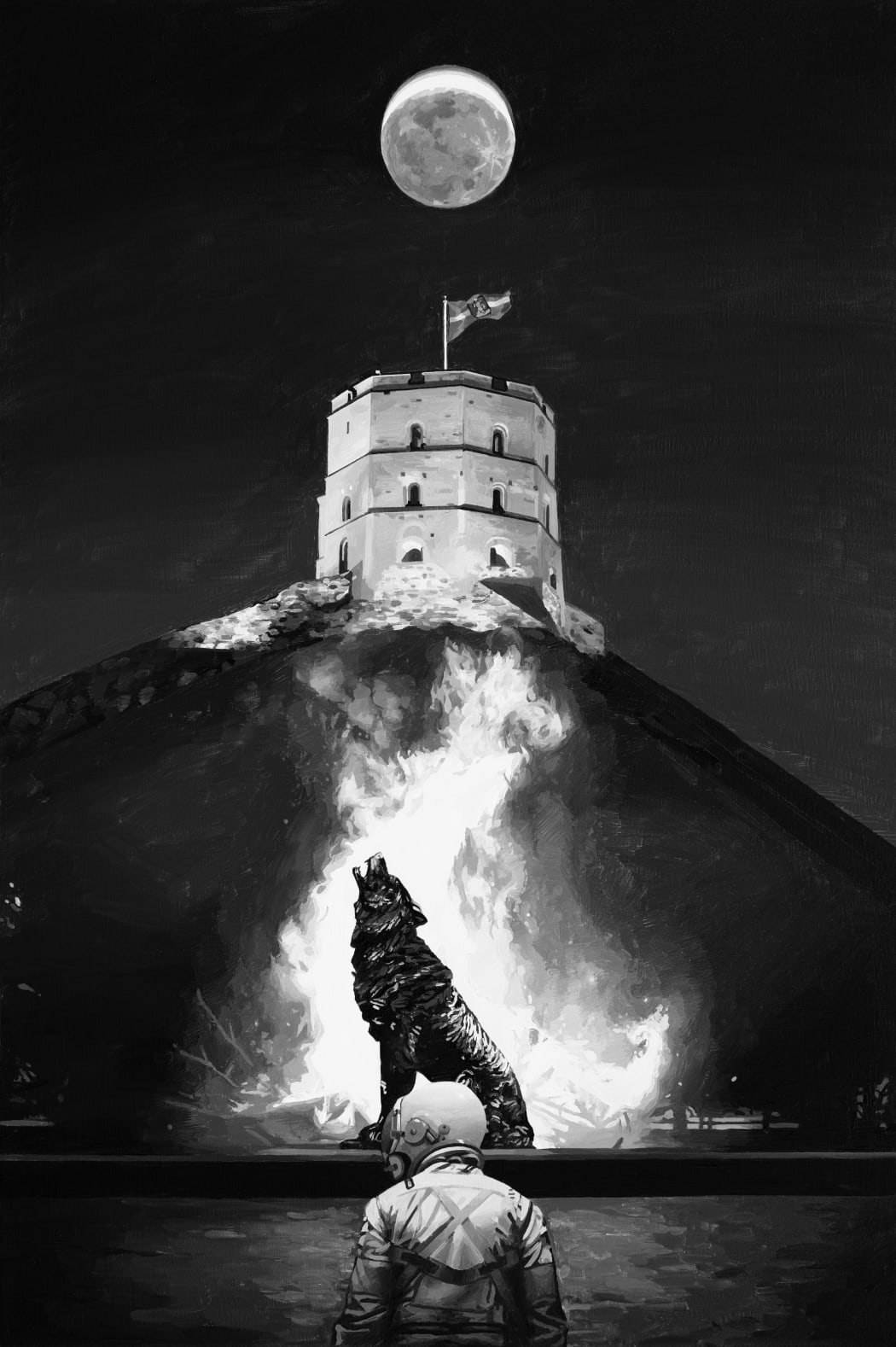
Last fall Scott Listfield and his brother took a trip to step into their ancestor's footsteps. Each painting in this show is from a stop along the way.
The Equinox
Here's a story about a wolf.
It begins a long time ago when a much younger version of me went off to Europe for the first time. I studied in Italy. I walked cobblestone streets. So many cobblestone streets. I rode trains and saw places I might never see again. I came home and those journeys eventually inspired me to paint astronauts.
Last fall I traveled to Europe again. From Oslo I flew to Riga, Latvia and met up with my brother at the airport, who had arrived just before me from Boston. We spent the next week traveling through Latvia and Lithuania to the places where our ancestors once lived. I didn't really have any preconceived notions as to how this part of the trip would go. There would probably be no long lost Listfield cousins to find. No one in my family is left in this part of the world. I guess I wanted to see where I come from. I wanted to walk the same cobblestone streets my ancestors once did. I didn't expect anything profound to happen. It did though.
Our trip ended in Vilnius, Lithuania's very charming capital city. Arriving late, and tired from the road, we wound up by chance walking along the river that winds its way through the center of town. The sun was setting, and it was a mild September night. People were about. Lots of people. So very many people. My brother noticed it first: something was happening. That's when we saw the wolf.
On the riverbank just ahead of us was a large statue of a wolf. Looming over it was an ancient castle tower, lit dramatically from below and perched precariously on a hill. As the last bit of sunlight faded, the wolf spoke.
I don’t speak Lithuanian, but some quick googling revealed that the wolf was sharing the story of the founding of Vilnius. It spoke in a booming voice, with occasional pauses as music swelled. Fire from an unknown source danced around the bottom of the wolf and eventually, as the night wore on, it was engulfed in flames. Smoke and hot ash fell on our faces. I wondered if we were a safe enough distance away.
As the fire subsumed, we wandered off, dazed, along the river bank with hundreds of Vilnius residents. We had just celebrated the fall equinox and the 700th anniversary of the founding of Vilnius. It felt like we had just been part of something very primeval. I felt Lithuanian. I felt pagan. I felt wolf. I returned to my hotel room, ash still on my face.
Epilogue: My third great grandfather was born in the small town of Šėta, Lithuania, sometime around the year 1837. His name was Wolfe.

The Wolf House
I arrived in Oslo knowing that the show I was supposed be having there had already been canceled. Something tragic had happened with the gallery curating the show, just a few days before I left for Scandinavia. It was too late to cancel my trip, and so I went anyways, trying not to let the sadness and suddenness of that tragedy hang over me while I traveled. But once I arrived in Oslo, the dark clouds and rain felt like a reminder. It was hard to shake the feeling of sadness hanging over both me and the city. But after a day in Oslo, I was joined by another artist who was supposed to be in the show. She too, had bought a plane ticket not knowing the whole thing would be called off, and so both of us, in town for no real purpose, wandered Oslo in the rain. We tentatively talked of the tragedy. She suggested we light a candle in one of the towering cathedrals in town. Despite neither of being particularly religious, I liked this idea. We stopped at a local bakery for a light lunch, and then took a corner and found ourselves facing a cobblestone street and a small, brightly painted house. I felt my spirits begin to lift and later that day the clouds began to break and we spotted the sun over Norway for the first time.
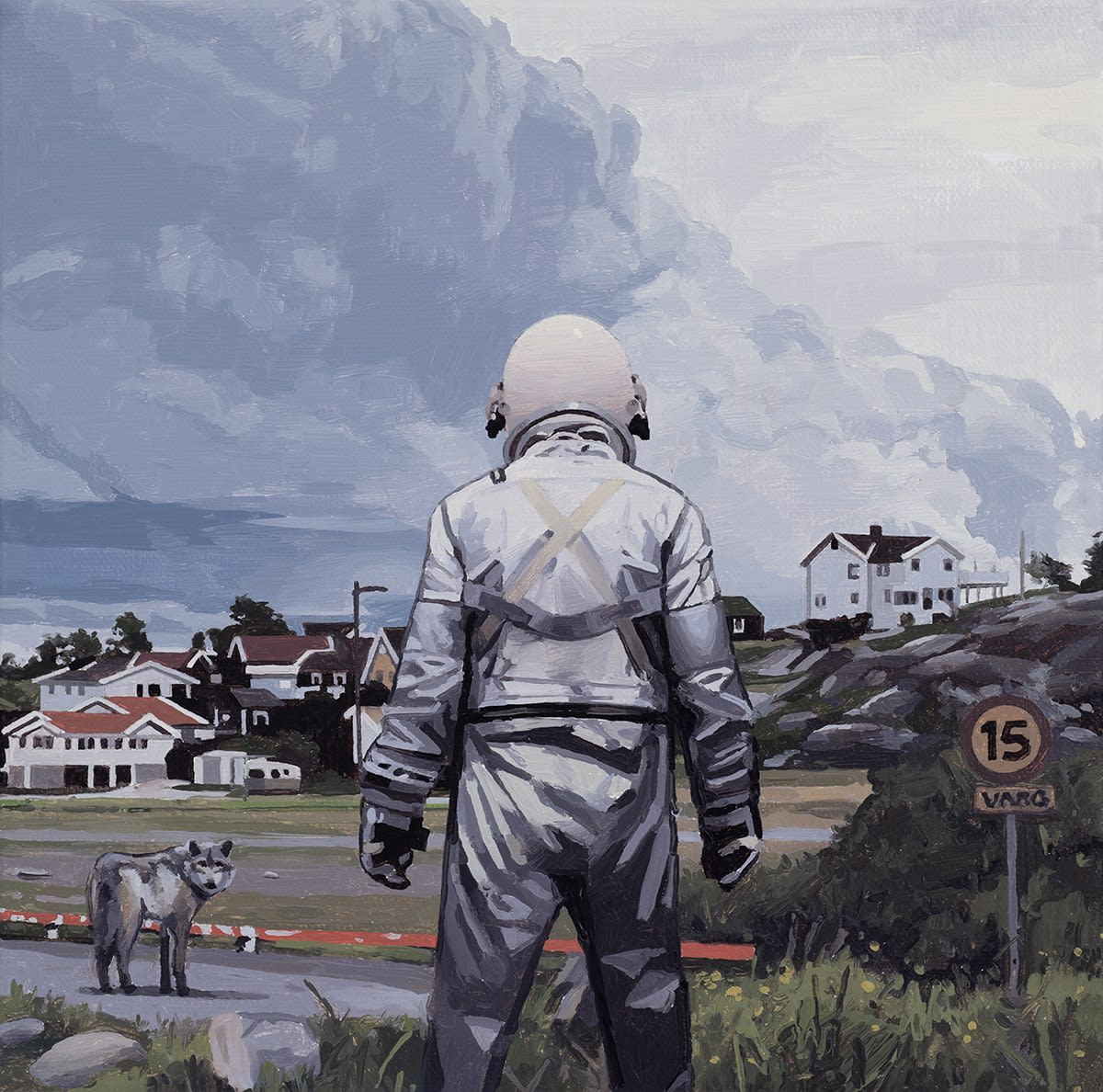
On The Island
I spent three days in Gothenburg, a truly lovely city with canals, street cars, and countless hills on Sweden's western coast. Carved out by glaciers and the sea, archipelagos dot the coastline, and on my last day there I hopped a train from the city center out to the town where the ferry departed. I spent the day alone, wandering the small villages, forests, and hills of those Swedish isles. In some ways it reminded me of visiting my grandparents when I was very young, who lived near the sea north of Boston, Massachusetts. In other ways it reminded me of no place I'd ever been before. Clouds rolled in and out over the rocky landscape, but it never rained and eventually the sun broke through and warmed me as I got lost in the forest, the high grass, and the many meandering inlets of the islands.

The Red House
On the island outside of Gothenburg, Sweden, I spotted a hill. Most of these islands are small and low lying, and the hills modest. But this one, carved from rock, pointing up from the sea, captivated me from as soon as I departed the ferry. I made a line for it and clambered up it's side. At the top was a tiny red house, more of a shack or a shed, really. I'm not sure what it's purpose was, whether it once operated as a lighthouse, or merely a one room place to lie down for a night and monitor the activity of the nearby islands. But when I crested the hill, I knew this was a place I'd remember forever. The clouds, a constant companion during my exploration of these small islands, had parted, drifting outward toward the horizon and letting the sun shine down. I looked out over the sea, across the numerous multicolored rooftops, and felt surprisingly at home in a place that also felt otherworldly. I let the sun warm me as I soaked in as much of the view as I could. The next morning I'd be leaving for Oslo. I might never make it back to this part of the world again, and I wanted to remember as much of it as I could.
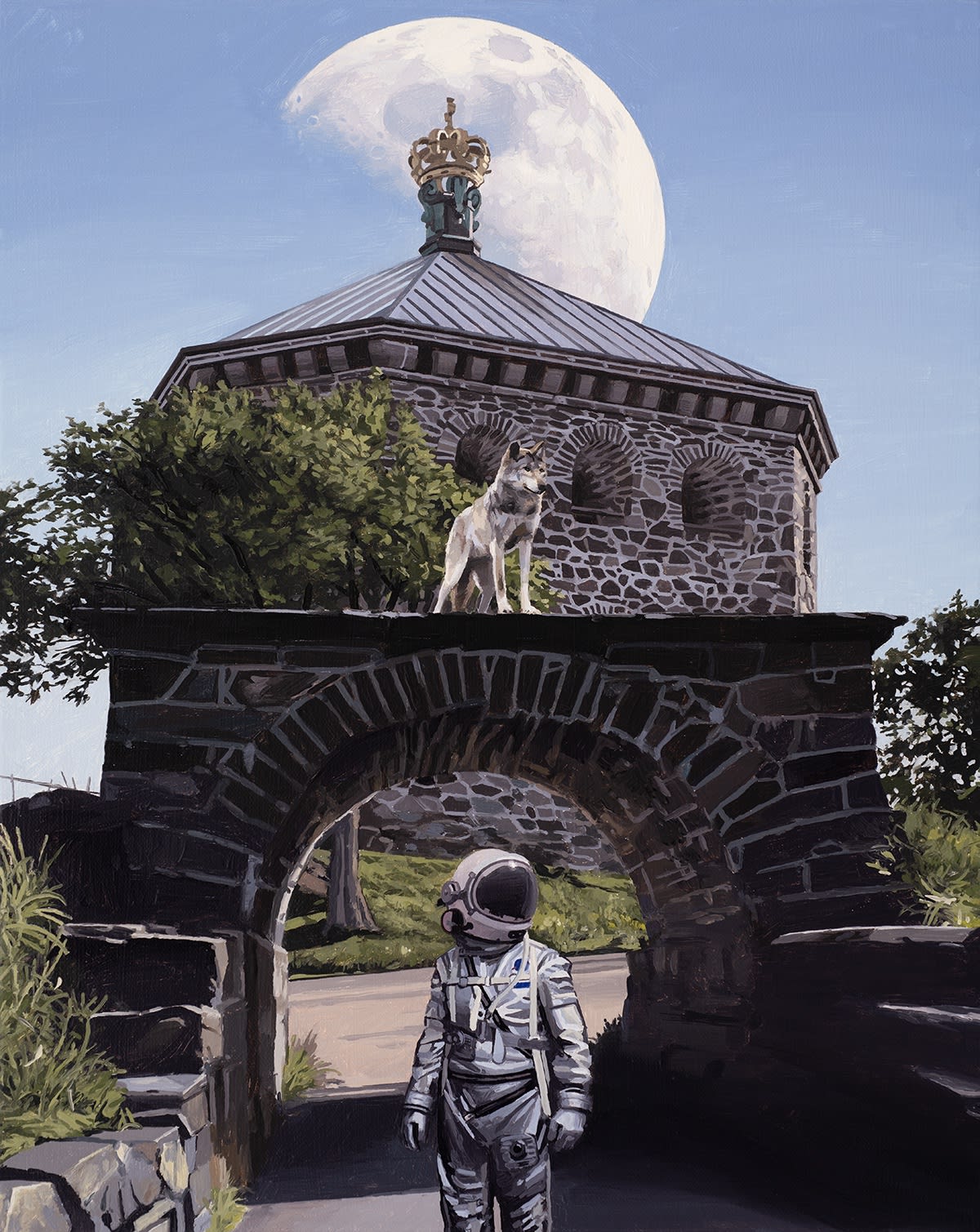
The Archway
Perched high on a hill overlooking the old town in Gothenburg is a fortress. My first day there I climbed the hill, looking for the high ground to get views of the entire city. Gothenburg has countless hills and, to my delight, countless stairways leading up those hills. I spent the day climbing hills and visiting stone forts and wooden chapels, bridges over canals and streams and wandering through forested parks. This was still early in my trip and only in hindsight did I feel the presence of a wolf companion. I hadn't yet visited the places where my ancestors were from. But I felt like I was, in a way, retracing the steps of a much younger version of myself. Although I had never been to this part of the world before, I spent a formative part of my life traveling through Europe, largely on my own, and those travels shaped who I am and inspired me to make my very first paintings of astronauts. A lone traveler, lost in a world that is recognizable but not his own. History hangs over this place. It's not my history. But now that I've been there and seen it in person, it becomes part of my own story.
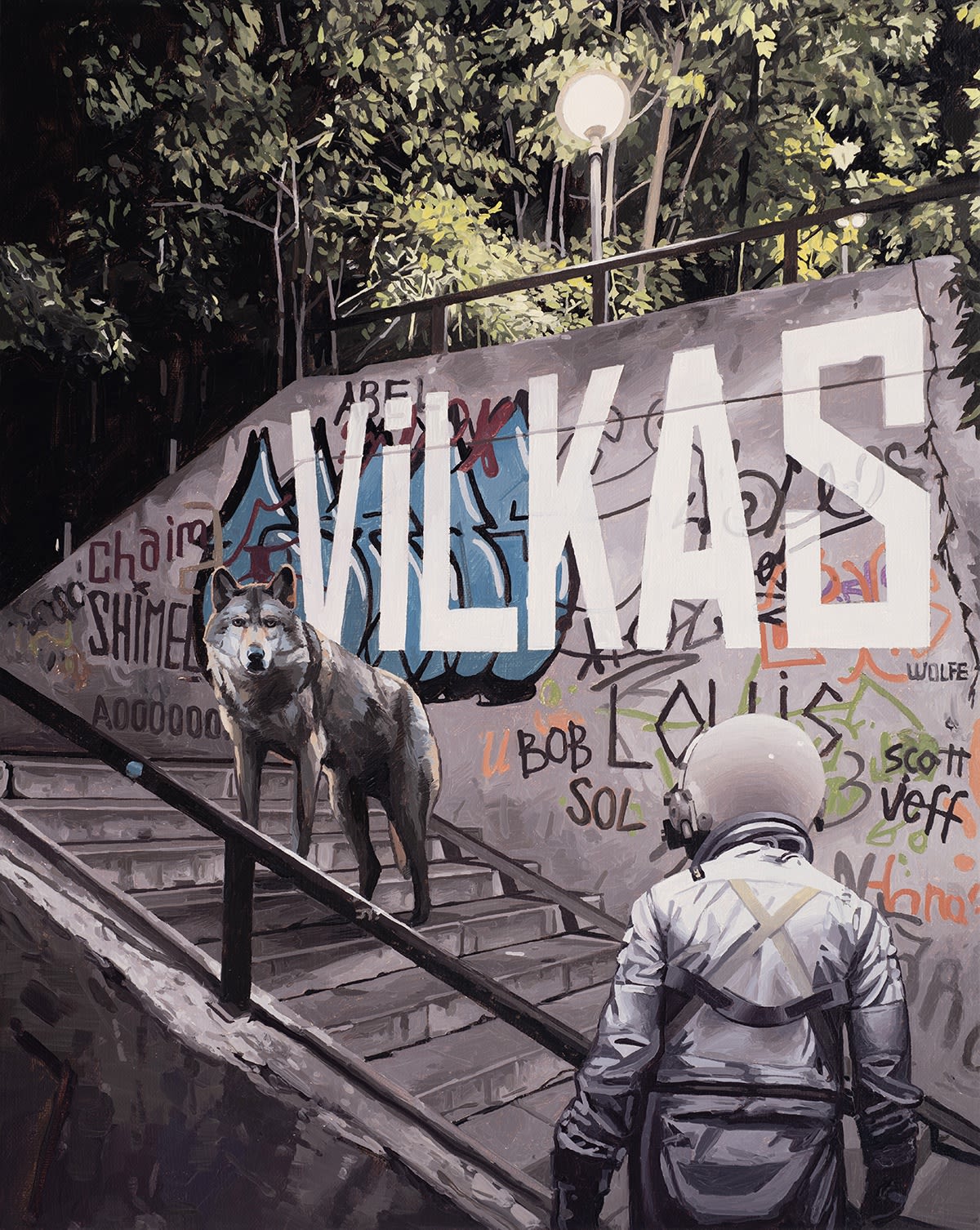
The Stairway
People who know me well know that my unusual pastime of choice is to walk stairs. I moved to Los Angeles from Boston around 5 years ago. When the pandemic hit, and I found myself locked in and bored, and I began walking the numerous stairs cut into the hills and mountains near my new home. When I arrived in Kaunas, Lithuania with my brother, after spending the previous days visiting smaller towns where our ancestors once lived, I was excited to find that Kaunas had hills and stairs of it's own. I spent our first night there tentatively exploring the ones nearest where we were staying, then my brother joined in the following morning as we explored the city from it's highest points, climbing hills to churches and monuments, statues and overlooks, occasionally hopping an ancient funicular along the way.
This particular stairway, captured that first night in town, was covered in graffiti and bright lights lit up the forest hanging above it. The wolf who appears in each painting in this show represents a few different things, but I think of it primarily as a ghost of my ancestors accompanying me on this trip where I visited the places they once lived. Vilkas means wolf in Lithuanian. And the names written on the wall are my direct patriarchal line. Listfield's starting with me and my brother, and going backwards – my father, my grandfather, my great-grandfather – all the way back in time, as far as I can trace. The ancestors who lived in this part of the world, those of us who had never been there, and then me and my brother, visiting for the first and maybe only time, to see the places where we come from.

The Wall
Unsurprisingly, when traveling through old European cities, I saw a lot of statues on this trip. Monuments to leaders long gone, kings and noblemen and warriors. A whole mythology to remember glorious achievements from the past. I also visited crumbling walls and overgrown sites of battles and massacres. Some were entirely unmarked. Left for nature to reclaim them. I visited places where distant family had been killed during various wars. Murdered for no real reason and tossed into a pit. These parts of my trip were sobering. In some of those places the memory burned bright. Statues and plaques and historical markers, so that no one would forget what had transpired. In other places there was less than nothing. Just roads to nowhere, overgrown forests, nothing at all to indicate the lives that had been fought for and lost in those places.
I wanted to combine many of those things into one image in this painting. The crumbling walls, the statues, the forests and overgrown plots of land. I placed the name of my own ancestor on the statue. My third great grandfather's name was Wolfe. A coincidence I only realized later, after the wolf had already become the defining figure of this story. Wolfe led a modest life. He was a teacher in a small town in Lithuania. His son Chaim left for England, and a better life hopefully, and eventually he joined him there, in Leeds, where he passed in 1902. There is no monument to his struggle. I'm not sure there is even a gravestone. But here, in this painting, there is.
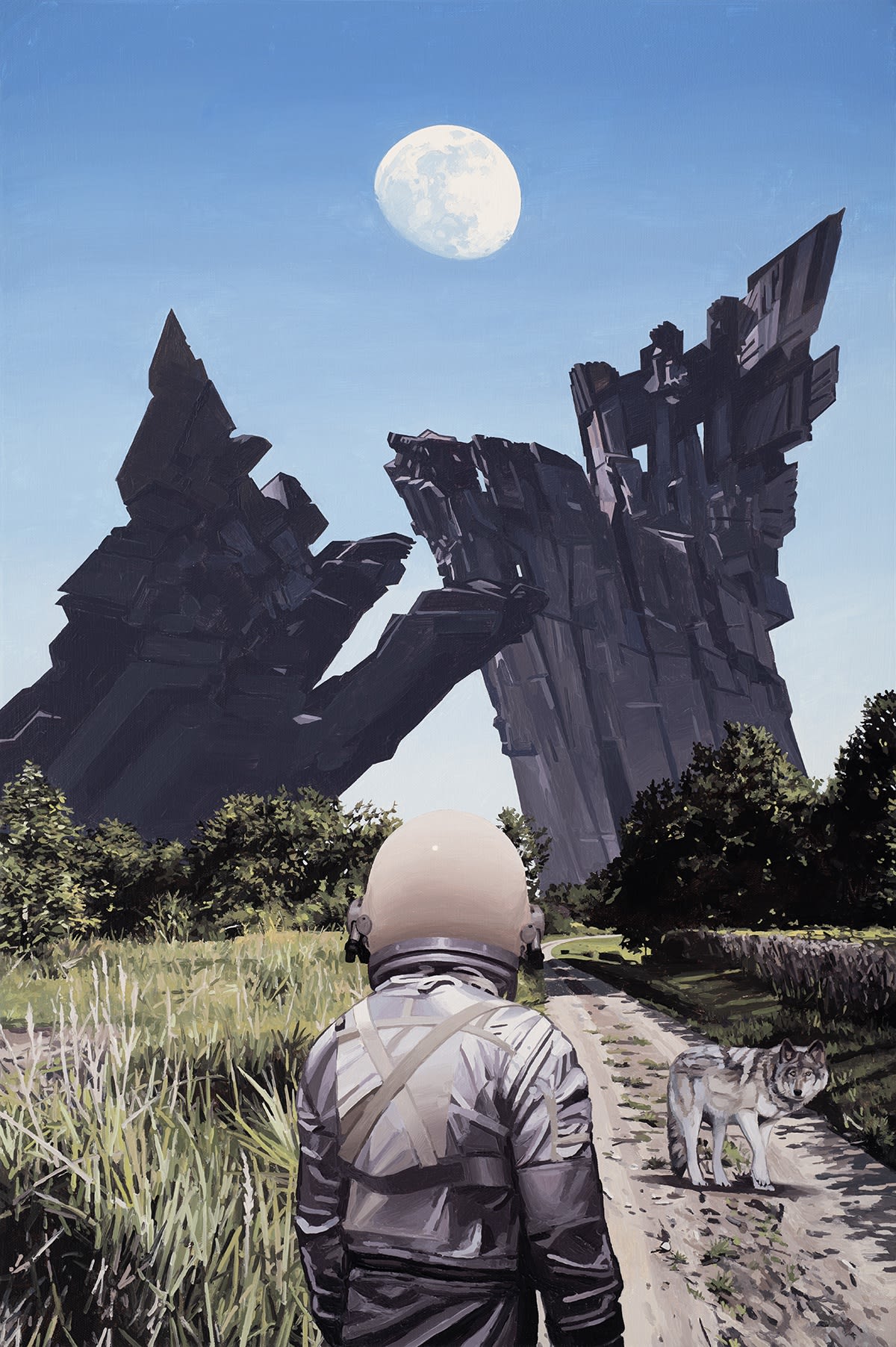
The Road
On the far outskirts of Kaunas, Lithuania is a place called the ninth fort. It was completed just before World War I and served as one of a series of defensive bastions for the city. When the Soviets swept in at the beginning of World War II, it became a jail for political prisoners. During the Nazi occupation later in the war it became a massacre site, mostly for the local Jewish population. I don't know if anyone in my family ended up there, but it's certainly possible. After the war, the Soviets reclaimed the site and erected a haunting monument to those lost in the Nazi massacre.
This site was one of the more sobering stops on my trip, and yet I was captivated by the beauty of the monument itself. In this painting I've remade it, but placed it far from the manicured lawns and rolling hills of the site itself. The dusty road and high unkempt grass is from a different stop on our trip. Another massacre site. Another place my ancestors might have lived and might have died. This place was forgotten. No marker. No towering monument. Only forgotten memories. This trip, the good and the bad, the remembered and the forgotten, lies along that road. My brother and I followed it to wherever it went. We didn't know it at the time, but there was a wolf there, too. Sometimes it led and sometimes it followed. The wolf lived there, somewhere, along that road.

The Plaza
My trip wrapped up in Vilnius, Lithuania's stately capital city. Filled with towers and churches, monuments and plazas, my brother and I spent three days walking the city, coming to grips with the places we had seen on this trip. We had spent the previous week visiting smaller towns where our ancestors came from. In some of those places I felt the memory of that history, still alive and vibrant, despite there being no living members of my family still there. In other places, the history had been literally bulldozed. Empty fields and abandoned roads where people once lived and where people once died, overgrown cemeteries that in another generation or two will be lost forever. I felt caught between my own family history, the lives they lived, largely uncelebrated but key to my own existence, and the grandeur of monuments to cities and kings and saints. The two began to blend in my mind. This trip had been something like me creating a monument of my own to my past, my ancestry, to those who came from the small towns, to those who lived and dies, those who fled, and those who didn't make it out in time. There are monuments in my mind mind now also monuments in my paintings, to those people who came before me.
Enquire here to request details of available works by Scott









